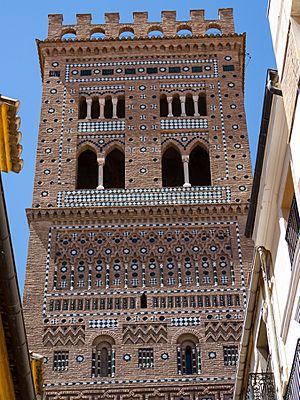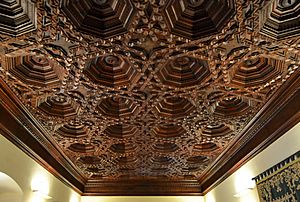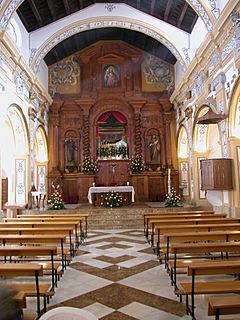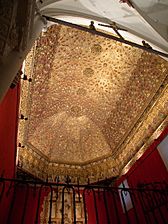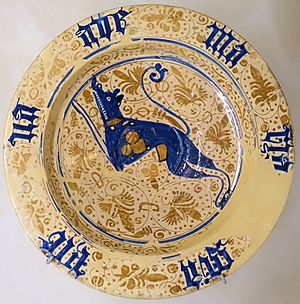Mudéjar art facts for kids
Mudéjar art, also known as Mudéjar style, was a special kind of art and decoration. It was used in Christian kingdoms in the Iberian Peninsula (modern-day Spain and Portugal) mostly between the 1200s and 1500s. This style mixed ideas from Christian art (like Romanesque, Gothic, and Renaissance styles) with designs and building methods from Al-Andalus, which was the Muslim-ruled part of Iberia.
Mudéjar art wasn't just for buildings. It also appeared in other art forms and crafts. A great example is Hispano-Moresque lustreware, which is a type of shiny pottery. This pottery was very popular and was sold all over Europe from southern and eastern Spain.
The name Mudéjar art was created by an art expert named José Amador de los Ríos y Serrano. He named it after the Mudéjars. These were Muslims who stayed in areas of Al-Andalus after Christian rulers took them over during the Reconquista (the Christian reconquest). The Mudéjars were allowed to practice their religion to some extent.
Because of this, Mudéjar art shows how Muslims and Christians lived together peacefully during the Middle Ages. However, it's important to know that later, in the late 1400s and early 1500s, all Muslims and Jewish people in Spain were eventually told to become Christian or leave the country.
Mudéjar decorative styles were mostly developed for buildings. Later, in the late 1800s and early 1900s, there was a new interest in this style in Spain and Portugal, leading to the Neo-Mudéjar style.
Contents
What does "Mudéjar" mean?
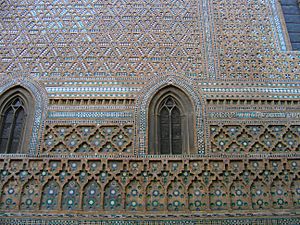
The word Mudéjar was first used for Muslims who stayed in Al-Andalus after the Christian armies took control. These Muslims were not forced to change their religion right away. The word comes from the Arabic word Mudajjan, which means "tamed." It referred to Muslims who accepted the rule of Christian kings. Some people think the word might have been used to tease them, as it was also used for farm animals. However, it can also mean "one permitted to remain," showing that Christians allowed Muslims to stay in Iberia.
The idea of "arte mudéjar" (Mudéjar art) was first explained by the Spanish art expert José Amador de los Ríos y Serrano in 1859.
Muslims in Christian Kingdoms
Muslims living in the Christian kingdoms of the Iberian peninsula during the Middle Ages were called Mudejars. They were generally allowed to practice their religion, but with some rules.
However, after the last Muslim kingdom, Granada, was taken by the Christian Castile in 1492, Muslims were given a choice. They had to either become Christian or leave the country. This happened first in Castile and then in Aragon. Those who chose to become Christian and stay were called Moriscos. People often suspected them of secretly practicing Islam. Eventually, many Moriscos were forced to leave Spain after 1609.
The Mudéjar culture was able to survive and grow in the Christian kingdoms because of several reasons. These included how the Christians took over the land (whether by agreement or fighting), how many Muslims and Christians lived there, and the interests of the king and the church. When these things were balanced, Mudéjar art was born. Because of these local differences, the Islamic influences in Christian buildings varied a lot from region to region. But all these styles are grouped under the name Mudéjar art.
Mudéjar Style in Buildings
Mudéjar style in buildings means using Islamic-inspired designs and patterns on Christian-style architecture. It's believed to have started with Muslim builders who used their traditional building and decorating skills. These skills then became part of the local Christian way of building. They were used on Romanesque, Gothic, and Renaissance buildings as the Christian kingdoms grew. These decorative techniques included fancy writing (calligraphy), detailed geometric shapes, and plant designs, all from Islamic art.
Mudéjar building methods were simple and very effective. They used materials like brick, other artificial stones, and wood. These materials were not only for building but also for decoration. Brick was very important because it was easy to work with, strong, looked good, and was cheap. This made it perfect for buildings that needed to be built quickly.
Mudéjar decoration includes stylish writing and complex geometric and plant shapes. Classic Mudéjar features are the horseshoe and multi-lobed arches, muqarna vaults (a type of ceiling decoration), alfiz (a frame around an arch), wooden roofs, fired bricks, shiny ceramic tiles, and decorative plasterwork. Mudéjar plasterwork, sometimes called Yeseria, uses all the Islamic designs. These include writing, “atauriques” (plant-like designs), and geometric patterns. Sometimes, Christian art designs like Gothic plants and shields are also included, but they are shown in an Islamic style, which uses bright colors.
Mudéjar art often uses girih patterns, which are geometric strapwork designs. These were common in Middle Eastern buildings. In contrast, buildings in the Maghreb (North Africa) often used plant-like arabesques. Experts sometimes thought geometric forms were new and arabesques were old-fashioned. But in Al-Andalus, both geometric and plant designs were used freely and mixed together.
Mudéjar in Spain and Portugal
When Christian rule returned to the areas of Iberia that were once Muslim, different Mudéjar building methods became popular. These methods used inexpensive materials like brick, wood, and stucco. Experts generally agree that Mudéjar art in buildings first appeared in the northern town of Sahagún in the 1100s, in the Christian Kingdom of León.
Mudéjar style then spread to other parts of the Kingdom of León. Good examples can be found in Toledo, Ávila, Segovia, Toro, Cuéllar, Arévalo, and Madrigal de las Altas Torres. Later, the Kingdom of Castile helped spread Mudéjar to southern Spain. A beautiful example of Mudéjar Renaissance style is the Casa de Pilatos, built in the early 1500s in Seville. Seville has many other examples of Mudéjar art. The Alcázar of Seville is considered one of the best examples of Mudéjar Gothic and Mudéjar Renaissance architecture. However, its famous Mudéjar Rooms were actually built by architects from the Islamic Emirate of Granada, similar to the style of the Alhambra.
Mudéjar art also appeared in the north-eastern Christian Kingdom of Aragon in the 1100s. More than a hundred examples still exist there, mostly in the valleys of the Ebro, Jalón, and Jiloca rivers. It started in two ways:
- First, in royal buildings linked to the Christian kings, like the Aljafería Palace. This palace was originally Moorish and was changed and expanded, keeping Islamic decorations.
- Second, in a style that used brick instead of stone for Romanesque buildings, often with Spanish decorative patterns. Examples of this type of Mudéjar can be seen in churches in Daroca, which started with stone but were finished in the 1200s with Mudéjar brick panels.
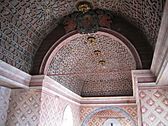
Portugal had fewer Mudéjar buildings, and they usually had simpler Mudéjar elements. The Church of Castro de Avelãs in Braganza shows classic Mudéjar brickwork. Mudéjar was also often added to the Gothic Manueline style in Portugal, which was very fancy. Portugal's use of Mudéjar art grew in the 1400s and 1500s. Buildings like the Palace of the Counts of Basto and the Royal Palace have special wooden Mudéjar roofs. These roofs can also be found in some churches in towns like Sintra and Lisbon. Since trade was very important to Portugal in the 1500s, Mudéjar art tiles from Seville were brought in and used in churches and palaces, like the Royal Palace of Sintra.
Mudéjar in Latin America
Christian builders and craftspeople brought Mudéjar style elements to the Spanish colonies overseas, especially in the 1500s. These elements were added to Renaissance buildings before the Baroque style became popular. Mudéjar design in the New World was seen as a continuation of the unique mix of styles from Spain.
The Church of San Miguel in Sucre, Bolivia, is an example of Mudéjar in Hispanic America. It has Mudéjar decorations inside and an open floor plan. You can see Mudéjar geometric designs in its octagonal wooden ceiling. The underside of the supporting arches are carved with plant designs based on the arabesque. San Miguel directly follows the Mudéjar tradition of repeating and expanding a pattern. Around the octagonal dome, there are more wooden ceiling panels with the same pattern as the church's main ceiling. The white stucco walls also show the influence of the Baroque style, showing how different cultures mixed in Spanish architecture.
Other important examples of Mudéjar design in Latin America include:
- The Monastery of San Francisco in Lima, Peru. Its main and side vaults are painted in Mudéjar style. The halls of the main cloister have tiles from Seville, and the main altar is made entirely of carved wood.
- The Iglesia del Espíritu Santo in Havana, Cuba.
- Other examples can be found in Coro, a UNESCO World Heritage Site in Venezuela.
Mudéjar Style in Other Arts
Decorative Arts
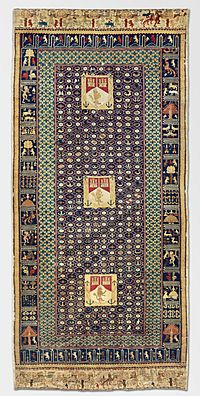

Mudéjar artists brought detailed geometric designs to the Christian kingdoms. These designs were used in tilework, brickwork, wood carving, plasterwork, ceramics, and metal decorations from Al-Andalus. Objects, as well as ceilings and walls, were often decorated with rich and complex designs. Mudéjar artists wanted to create a sense of wonder and show off the richness of the materials and decorations. Many decorative arts, like tiling, ceramics, and carving, were used to decorate buildings.
To make walls and floors lively, Mudéjar art developed complex tiling patterns. The designs on tiles were often abstract, focusing more on plant designs and less on pictures of people or animals (which was common in Islamic art). The colors of Mudéjar tiles were much brighter and more vibrant than other European styles. The way they made tiles was also typical of techniques used in Islamic Iberia. The tile was fired first, then cut into smaller, easier-to-handle pieces. This method meant that the tiles and glaze shrank less when fired, keeping their designs clearer. This allowed the tiles to be placed closer together with less grout, making the patterns more detailed and connected.
Ceramics
Ceramics were a very advanced art form during the time of Islamic rule in the Iberian Peninsula. Mudéjar style ceramics built on the techniques developed over centuries of Islamic art. Pottery centers all over Spain, like Paterna, Toledo, and Seville, made many different objects, from bowls and plates to candlesticks.
Mudéjar style ceramics usually came in three main "styles": green-purple ware (using manganese green), (cobalt) blue ware, and gold-glazed ware (lusterware). Mudéjar artists brought their perfected glazing techniques to Medieval Europe. Mudéjar pottery from Manises, Paterna, and Teruel were very popular. They could create a clear glaze by mixing lead and tin for a shiny, opaque white glaze. Mixtures of metal oxides were put on the glazed and fired surfaces to create a lustrous (shiny) decoration. This technique was carried on from the Nasrid period.
Artists would typically put a layer of opaque white glaze on first, before adding colors. On top of the white, they used cobalt blue, green copper, and purple manganese oxides to make bright, shimmering surfaces that looked like gold and other precious metals. Like with tile and stucco work, ceramic designs included plant patterns, as well as animal figures, fancy writing, and geometric patterns. There are also Christian influences in the images, such as boats, fern leaves, hearts, and castles.
Neo-Mudéjar Style
Mudéjar art has been brought back in modern times. The most important revival in Spain and Portugal was Neo-Mudéjar, which appeared in the late 1800s and early 1900s. This style combined modern architecture and materials, like cast iron and glass, with Mudéjar art elements such as arches, tiling, and brickwork.
Some Spanish architecture companies now work on building projects in modern Arabic-speaking countries, like Morocco, Algeria, and Eastern Arabia. In these places, Mudéjar art influences are often requested for homes. Mudéjar features continue to be a base for modern styles. Muslim architects are also making big advancements in modern architecture, showing off technical and engineering skills, as well as artistic talent, similar to the Mudéjar styles.
Images for kids
See also
 In Spanish: Arte mudéjar para niños
In Spanish: Arte mudéjar para niños
- Artesonado
- Mudéjar Architecture of Aragon
- Moorish Revival architecture
- Walls of Cuéllar


